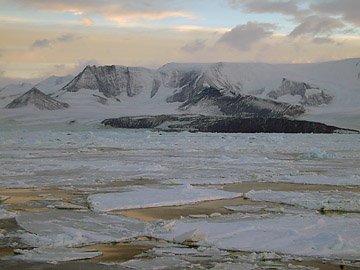
Breaking First-Year Ice

This is a view looking west at some unnamed peaks that form the edge of the Detroit Plateau on the Palmer Peninsula. The foreground is first year ice with pieces of multi-year ice closer toshore. The area that looks like water between the ice blocks is actually a form of ice called grease ice. It is semi-solid seawaterthat would not support any weight but is viscous enough that as the boat passes it deforms by flowing like thick maple syrup (the good stuff) over itself. Watching it move is hypnotic. These open areas provide access to the sea for the seals living on the ice floes.
Today we have been mapping a sub-sea basin using the ship's seismic system. The basin ranges from three to 900 meters deep and should provide an excellent site to collect cores later tonight. Deep basin sediments are not disturbed by passing icebergs or glacial advances that might scour or disrupt the sequence of sediments in shallower water. The day has been filled with spectacular scenery and very cold temperatures. The sea ice around the ship is littered with Crabeater and Weddell seals, which slowly move out of the way of the oncoming ship. We are continuously breaking first year ice that is relatively thin (6 to 18 inches), and poses little problem for the ship. In the galley (dining area) which is just above the water line and near the bow of the ship the noise of the breaking ice makes conversation impossible. As one wag noted, the galley is the place you cannot wait to get into at mealtime and as soon as you're there, cannot wait to get out of.
Everyone has settled into the routine of life aboard ship. Rooms are doubles with one person on the day shift and one on the night. This way the person who is trying to sleep is not disturbed by their roommate no matter what time of the day or night it is. Every room is equipped with a bathroom and shower and there is unlimited fresh water for showers. Freshwater is made by distilling seawater. Other amenities include a gym with exercise bicycle, treadmill and weight machines, washing machines and dryers, a lounge with a large screen TV and hundreds of movies, all of which you have seen at least twice except for some really odd titles that you have never even heard of.
There is also a sauna. Most people spend a few hours after their shift on the bridge enjoying the scenery and taking photos, then it's off to bed.
This afternoon several of us had a tour of the ship's engine room. Four large diesel engines drive two shafts to power the ship. With all four engines running, the ship uses 15,000 gallons of diesel a day. The engine room also contains the generator plant for the ship's electricity, the desalination units, a wastewater treatment plant and
a complete shop to repair anything that might break while at sea.
Tomorrow promises to be a busy day of coring and sample collecting. This includes lots of back deck activity and lots of water so hopefully it will warm up a little. The back deck itself is heated by a series of hot water pipes that run under the deck, but with the temperatures we are having the heaters will not keep up and the deck will quickly ice over. High pressure dominates the weather maps for our area so it looks like clear skies and cold temperatures.
Dave Tewksbury
tewksbda@nbp.polar.org